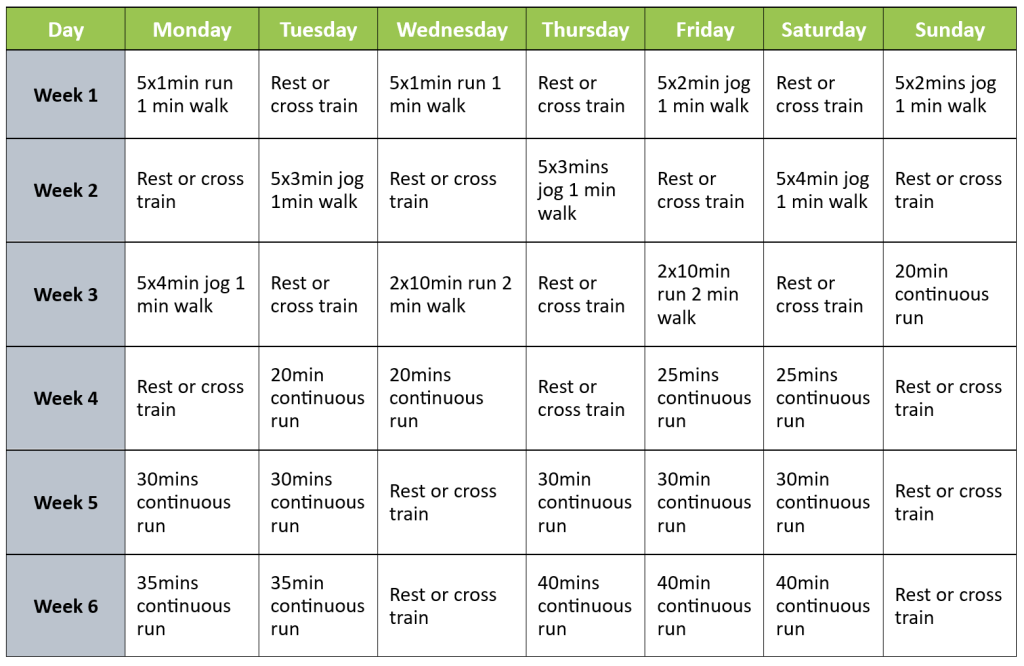
How Do You Safely Return To Running As Quickly As Possible After Injury?
As a runner, nothing is more frustrating than having to stop or reduce your running due to an injury, only to have the same problem flare up again when you get back into running. If you’re facing this issue, you may think that you need to rest for longer, but in some cases, resting for too long can actually be worse. When you spend more time out of running, you’re more likely to cause deconditioning of the main running muscles, which increases your risk of another running injury.
So, how can you safely return to running after an injury? While every runner and every injury is different, there are some simple guidelines you can follow to be more confident that you can get back on the road safely and without spending longer than necessary out of the action.
Return To Run Program Principles
You can use these principles to help you plan your return to running. If you are unsure about anything make sure you speak to your physio or coach, especially if you feel a return of any pain.
1. Type Of Injury
If the injury was any form of bone stress injury there should be no pain into the area on your return to running. Any pain into the area is a sign the injury needs more time to heal. While some injuries are fairly easy to manage and return from, if you’ve had a bone stress injury then you should definitely be working with your physio or coach as you get back to running.
For tendon injuries such as tendinopathies, it’s likely there may be some discomfort into the area when returning to running. To help you decide how much is ok to run through, use a 0 – 10 pain scale. If “0” = no pain and “10” = agony, pain that is low (<3/10) and stable (not worsening day to day) is safe to continue running with. If the pain is getting above 3/10, is getting worse or lasting longer after runs, or if the following morning feels worse than normal, then you’re probably overdoing it.
Muscle strain injuries will depend on the area and severity of the injury. For example a distance runner returning from a hamstring injury may be able to start running earlier than if they sustained a calf injury. The reason for this is that hamstrings only work at a low level when we run slowly, whereas the calf is already working at relatively high loads at even at jogging speeds. So the type of running you do, as well as the muscle that you have injured, can affect your return to run program.
If you’ve had a muscle strain injury it’s also important to make sure that you enough strength back in the muscle before returning to running. Some muscles are easy to test yourself, e.g. for a calf muscle you generally want to be able to do at least 25 full-height calf raises comfortably before getting back to running. Hamstrings and quads can be harder to check yourself, but you are generally looking for symmetry with the other side. Check with your physio if you aren’t sure if you’ve regained enough strength to return to running.
2. How Long Have You Had Off Running?
Typically the time you’ve taken off with your injury is the time it should take to get back to your previous level of running training. During a period out of running not only has the injured area deconditioned, but other areas in the body will have as well. Rushing back after a period of time off not only increases the risk of flaring up your original injury, but you also risking causing an injury elsewhere in the body. This is because our bodies are very good at changing the ways we move to reduce the load on a weakened structure. Sometimes this can be very subtle, like slightly changing the way we run to avoid overloading a recently injured structure. Short-term and low volume this can be ok, but when repeated 1000’s of times in our running cycle it can cause secondary injuries.
3. Your Previous Level Of Training
More experienced runners can jump back into higher levels of running loads faster than novice runners. This is because their bodies have been exposed to these loads over many years and they are therefore more resilient to injury. Novice runners need to take more time building back to their previous level of load because they don’t have the years of training behind them to strengthen their soft tissues and skeleton.
Example Return To Run Program
So what does a return to run program look like? Well, we want to emphasise here that you need to be on the right program for YOU, taking into account all of the points outlined above. There is no generic program that suits everyone. But to give you an example of how a typical program might be structured, you can look at the sample return to run program below. This is for a client who had been off running for 6 weeks. Prior to his injury he was running 5 days/week for approximately 40 minutes each run.

What’s the Best Cross-Training For Running?
Cross-training is really important while you’re not running at all, or doing less running volume as you come back from injury. It minimises the deconditioning (weakening) effect of time out of running, and also helps you maintain your cardiovascular fitness as much as possible. Generally we recommend cross-training on a bike as the best cross-training for runners. This is because it uses many of the important muscles that we use for running, so the cross-training effect is maximised to retain strength and conditioning.
If you can’t use a bike to cross-train, then other alternatives are water walking/running, using a rowing machine, or even swimming. There is less similarity between running and these alternatives however, if a bike is not an option, then they will definitely still be helpful.
To format your cross-training sessions, the easiest thing is to try and reproduce your planned running sessions on the bike (or whatever cross-training exercise you are doing). So whatever you would normally be doing as intervals/recovery/reps/time/intensity in your running session, do the same on the bike. Try to replicate the same intensity, e.g. using the RPE scale, on the bike as you would do if you were running.
Need Help Getting Back To Running?
These principles will give you a good foundation for planning your return to running following an injury. The real keys are to take it slow and listen to your body. Also, remember that often complete rest from running is not the answer (note: bone injuries (or potential bone injuries) are the exception to this and must be managed with caution!). Often running through a little discomfort, up to about a 3/10 pain level, is ok as long as it settles down fairly quickly after and feels ok the next morning. And remember that cross-training, preferably on a bike, is important to minimise deconditioning while you’re doing less running.

Ben Liddy, Head OF Running Performance
Running Physio & Certified Running Coach
If you need help with your return to run program, Ben loves working with runners of all abilities and is here to help. He has a unique skillset and experience that combines being a dedicated running physio as well as a Level 4 world Athletics Certified running coach. He has travelled internationally with Australian teams as well as working closely with state and national level athletes. This combination allows him to bridge the gap between injury rehab and returning to full running training and performance. He coaches and provides physio treatment to athletes ranging from Olympic/national level through to recreational runners. He spends most of his days coaching runners, doing running gait assessments, providing physio to runners, and mentoring our clinical team on everything running! If you need help with anything running related, including working out your return to run program, click below to ask a question or to book online.

